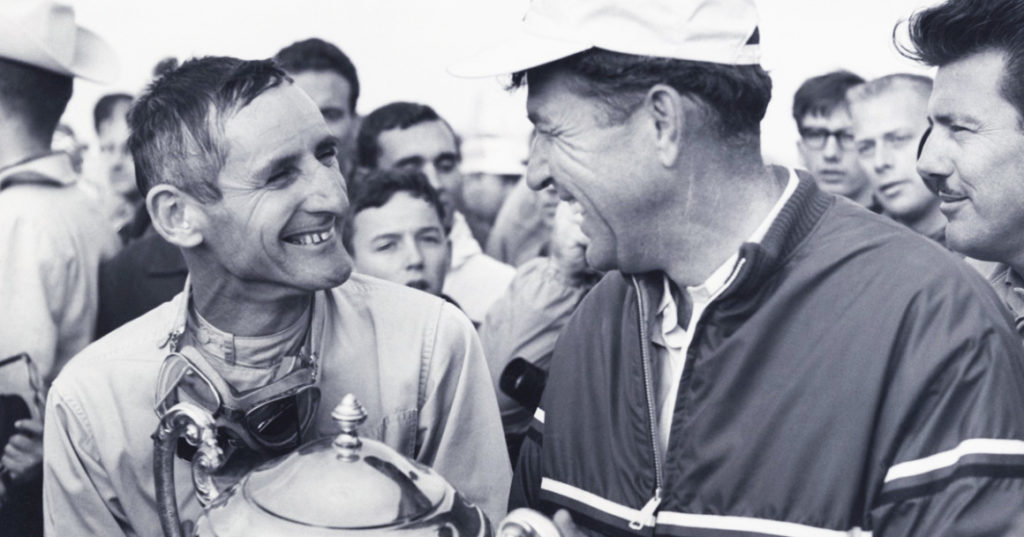If you were to pack in as many dramatic elements into a fictional retelling as Ford v Ferrari did in their true life-based narrative, I’d say it would have just too much going on. But as is usually the case in real life, you just can’t make this stuff up. Which elements of the story are based on reality and which are purely there to add some drama? I investigated the Ford v Ferrari true story to see what was real and what was fiction. Here’s what I found…
Spoilers ahoy for Ford vs. Ferrari. Flee to safety if you haven’t seen the film yet.
Ford v Ferrari true story
James Mangold’s Ford v Ferrari tells the story of Henry Ford II’s unsuccessful attempt to purchase Ferrari, the leading car manufacturer of race cars in the early 1960s. After Ferrari’s eventual purchase by Fiat, Ford’s anger fueled a heavy investment into his own race team in an effort to create a faster machine that could defeat Ferarri at the 24-hour race at Le Mans. He enlisted celebrated former driver and Le Mans winner Carroll Shelby and the talented Ken Miles to lead the creation of the new Ford race car and lead them to victory.
Getty Images | Twentieth Century Fox
Matt Damon as Carroll Shelby
Carroll Shelby began his racing career as a successful driver for companies like Aston Marton, but he was eventually forced to retire from driving due to health complications, as shown in the film. His career making cars with Ford, Dodge, Saab, and Oldsmobile is well documented.
With his business, Shelby American, he created the “Cobra,” a car with an American engine and the style of a European car. This caught Ford’s eye and led to their eventual collaboration on the GT40 as featured in the film.
Also accurate was the portrayal of the friendship between Shelby and Ken Miles. Even later in life, Shelby speaks highly of his friend and grieves his death. And though they were both known to be strong-willed and hot-headed, there’s actually no evidence that they ever got into any physical fights, as we saw in the fictional depiction. Their friendship, mirrored in the film, seemed to be based on mutual respect and admiration.
Getty Images | Twentieth Century Fox
Christian Bale as Ken Miles
We know how successful Ken Miles’ racing career was and his reputation for being stubborn. What is lesser known is how much of the drama between Shelby, Miles, and the Ford executives was dramatized. There’s a lot of evidence that he wasn’t well-liked, especially early on in his career, so it would be easy to believe that interactions between Miles and the huge corporate structure would be fraught with conflict.
But his attempt at being a team player by honoring the request for a PR shot at the end of Le Mans was accurate and did ultimately lead to him being denied the prestigious achievement of winning Sebring, Daytona, and Le Mans in the same year. Due to a technicality in starting points, Bruce McLaren and Chris Amon were declared the winners instead. In the movie, Miles is shown to take the loss gracefully, as was the case in real life.
Ken Miles’ death in the film is abrupt, to say the least. It happens at the very end of the movie with almost no explanation, merely a small interaction between Shelby and Miles’ son Peter and wife Mollie. This mirrors the real-life mystery of his death. Though we know that Miles’ perished while testing the new Ford J-car prototype they were creating shortly after finishing the 1966 Le Mans, we don’t know why it occurred, whether mechanical error or something else entirely. Most speculate that it wasn’t likely human error due to Miles’ well-known prowess and skill behind the wheel.
Ken Miles behind the wheel | Getty Images
What is shown in the film is the tragedy of his passing so shortly after being cheated out of the first place win at Le Mans due to Ford’s botched PR plan to have all of the remaining Ford cars pass the finish line together. It’s a true-to-life emotional tug and carries the end of the film.
In 2001, Miles was posthumously inducted into the Motorsports Hall of Fame of America. His legacy among racing fans merits the focus given to him in Ford v Ferrari.
Tracy Letts as Henry Ford II
Wikipedia | Twentieth Century Fox
In the film, Henry Ford II addressed the production line at a plant in Dearborn, Michigan. This isn’t likely to have been the case as he wasn’t known to address his plant crew directly but would send one of the many layers of executives in his place. It also isn’t likely that he would have ever been allowed to joy ride in the GT40 as his CEO status merited him far more care for his safety. I did very much enjoy his fictional reaction, though. Did he soil himself in the film? We may never know.
Twentieth Century Fox
The Ford executives, and particularly Leo Beebe, played by Josh Lucas, were shown to be mostly the bankroll to the win and not much more. The film portrayal of Beebe is very much the villain bent on getting Miles out of the way after an altercation turned them against each other. There’s much disagreement on his portrayal, though that’s often the case with any negative real-life depiction. Years later, Beebe said in an interview that his decision to pull the PR stunt was more based on safety to prevent the remaining cars from pushing each other off the road.
Lee Iacocca, played by Jon Bernthal, was portrayed as having direct negotiations with Enzo Ferrari to acquire his company. However, it wasn’t likely that Iacocca was among the contingent who traveled to Italy for those negotiations.
Do you have any insights into the Ford v Ferrari true story?
